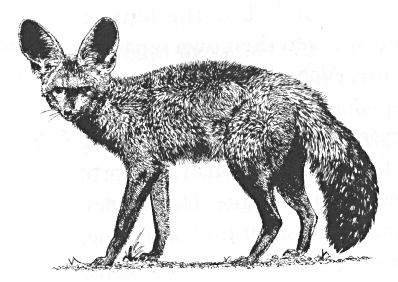

English Name:
-Bat-Eared Fox
Deutsche Namen
-Gro▀ohrfuchs (be carefull, in old publications the Kitfox(Vulpes velox)/Swiftfox(Vulpes velox hebes)
is also called so)
-Löffelhund/Löffelfuchs
Group
-
Lathin Name:
-Octocyos megalotis
appearance:
-Size: Both Male and Female 2,5 to 5 kg. (3-6Kg) = Average
weight
-Shoulder Height: Both Male and Female 35 to 40 cm.(25-30 cm)
-The ears can reach 10 cm. of lenght. =medium sized,
-lightly colored, huge dish-shaped ears, racoon-like colored
face. Oddly shaped body with overdeveloped Hindquarters, used for
pouncing and leaping, and underdeveloped forelegs used for
digging and holding. Front feet have sharp claws for digging and
highly-pointed muzzle has up to 50 small teeth used for eating
insects.
-somewhat jackal-like dog of the steppes, but also the long thin
legs that it a conferits graceful appearance.
Geographic Range:
-They were probably spread throughout the eastern and southern steppes of Africa in historic times, but today, human activities
have reduced their habitat to two widely separated areas: in the northeast and the southwest of Africa
-Horn of Africa and the Southern Africa. Found in the East African arid zones from Somalia to Tanzania and in the southwestern arid zones of Southern Africa.

Habitat:
-Savannas, dry lands,light Acacia woodlands to short grassland plains. Prefers areas where there is large ammounts of bare ground, especially sandy soild conditions, where it can dig an extensive lair of underground tunnels and burr ows.
Behaviour:
Activity: Primarily nocturnal, with heavy social and mating
activity proceeding sunrise and sunset. Stays in its cool burrow
system during hot daylight hours, emerging as daytime
temperatures begin to drop. Very active foraging activ ity from
sunset till after midnight, followed by intermittent rest and
foraging until another highly active period of foraging just
prior to sunrise.
- Nocturnal. During the day it rests in little shady ravines. It
lives in small familiar groups. Its enemies are: hyaenas and big
predatorys.
- Relatively little aggression between individual species
members. Male/Female pair-bonds are very interactive, spending
much time together grooming each other and raising their young
together. Foraging activity is usually done solo however,
pair-bonds will stay in close proximity to each other while
feeding.
-When they hunt for such quarry, they move with great care on
their long legs through the steppe grass, with their pointed
heads lowered and their large ears cocked forward. It is chiefly
by means of their ears that they discover their quarry. They
perceive the slightest sound that an insect makes, and they are
even able to hear the subterranean digging and gnawing noises of
that termites make white [SIC!] constructing lateral tunnels from
their nests. Once a bat-eared fox discovers something of that
sort, it locates the most promising site by turning its head from
side to side, and uses its forepaws to dig this tunnel up with
lightning speed. It captures insects and other small animals that
are moving through the grass, or insects that are just taking
flight much as other foxes do, with a high, mouselike leap.
-As a general rule, bat-eared foxes, which are threatened during
day light by active predatory birds, hunt at night. Only when the
young require large quantities of food, are they seen foraging
near their dens during the day.
-The bat-eared foxes are monogamous and hunt alone, one parent
remaining with the small whelps. Once the young are partially
grown, the bat-eared foxes avoid their enemies by resyming
nocturnal hunting in familial groups. They continue to do so
until the young become independent.
-The pair occupies a territory with boundaries marked by urine.
Depending upon the availability of food, the territory ranges
from 0.2 to 0.5 mi2 (0.5 to 1.5 km2) in size.
-A den will be dug in this territory, or one that has already
been dug by an aardvark will be taken over.
-If possible, the den will be surrounded by bushes and has
several exits.
-When their parents return to the den with food, they are greeted
in typical canine fashion. The older animals will regurgitate
food for them; larger quarry is carried in their mouths.
-As sounthusiastic as the greeting the whalps is, the
accompanying noise is quite reserved, and limited to a gentle
peeping.
-There are many other behavioral differences between these
animals and the other canids.:
*Thailwagging is common only among the whelps; it never occurs
after that time.
*The large ears confer a markedly different character upon the
facial expressions, especially since they are white inside and
black on the outer and uppter edges. The result is that the ears
serve for effective signaling. When the aminals are threatened,
the head is lowered to the ground, the back is arched, and the
tail is tucked between the legs.
-Apart from the peeping sounds that even adult animals produce,
especially when engaged in their favorite activity of grooming
once an other's coats, their only sound is a screech when
attacking. They do not howl in chorus.
-In the wild, bat-eared foxes are not shy in the presence of
human beings;
-the young in human care become quite trusting. However, they
have reproduced repeatedly in the Washington Zoo since 1950; a
litter of four was born in the Augsburg Zoo in 1969.
Reproduction
- searching for females: July
- Mating: Aug.-Sep. (depending upon local situations and climatic
conditions)
- From 2 to 5 offsprings (1-5)
- Longevity: About 5 years.
- No known listings, populations assumed to be heathly
- Litters size: 3-6,
- Gestation period: 65 - 70 days
- Birth time: Oct.-Dec.
- weaned up after: 15 weeks (quite long, twice as long as a dog)
- Young reach maturity size in approximately six months.
- independent at the age of ten months.
- The lifespan of the bat-eared fox in the wild is unknown; in
the Washington and London Zoos they lived less than six years.
Food Habits:
- This little animal feeds with little mammals, insects,
larvas, eggs, berries and fruit.
- Diet largely dominated by harvester termite, followed by dung
beetle larvae, grasshoppers, and a la rge variety of other
insects. Will also eat small rodents, ground-nesting birds eggs,
and small lizards. Hunting strategy varies depending on prey
type. Termites are simply licked-up, while beetle larvae are
furiously dug up after being pinpointed by i ts huge radar like
ears. Grasshoppers are caught in the air by leaping up and
twisting its body while in mid-flight.
-mice and insects.
-they even follow migrations of locusts that are so destructive
to field crops
-can be classified as the insectivores among the canids,
-even though like most representatives of their order, they also
eat small mammals, birds, bird and reptile eggs, small toads, and
fruits.
Specialities :
-
others :
-They are rarely hunted, however, and their existence may be
considered assured
-They have often been kept in zoos, but they do not appear to
reproduce there without difficulty
Links :
Otocyon megalotis - The University of Michigan - Museum of Zoology - Animal Diversity Web.